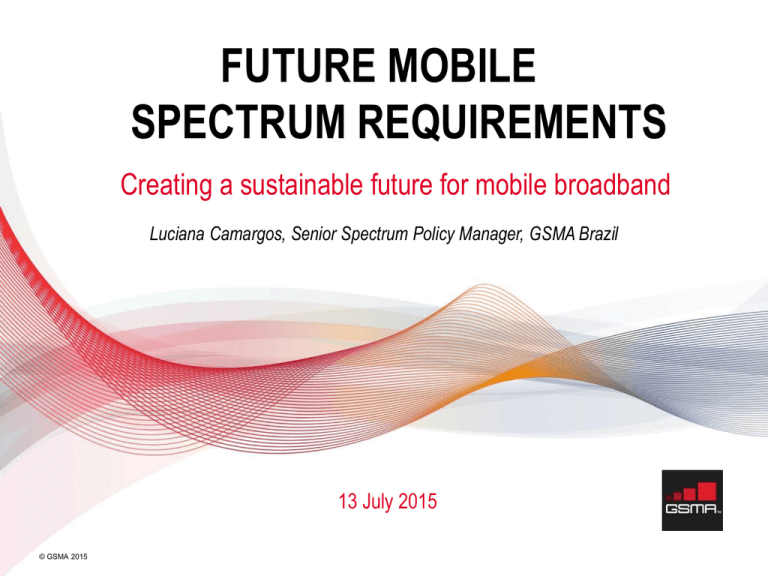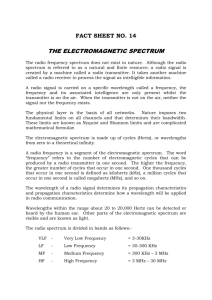FUTURE MOBILE SPECTRUM REQUIREMENTS Creating a sustainable future for mobile broadband
advertisement

FUTURE MOBILE SPECTRUM REQUIREMENTS Creating a sustainable future for mobile broadband Luciana Camargos, Senior Spectrum Policy Manager, GSMA Brazil 13 July 2015 © GSMA 2015 A MOBILE BROADBAND REVOLUTION SPECTRUM FOR MOBILE © GSMA 2015 SOURCE: MOBILE ECONOMY, GSMA 2014 MAJOR RECENT GLOBAL MOBILE DATA GROWTH ALMOST 20X DATA GROWTH IN ONLY 5 YEARS (PB/PER MONTH) SPECTRUM FOR MOBILE © GSMA 2015 SOURCE: ERICSSON MOBILITY REPORT FEB 2015 SIGNIFICANT GROWTH TO CONTINUE… Exabytes of data (per annum globally) GROWTH FROM 2014-2019 EXPECTED TO BE 6-10X SPECTRUM FOR MOBILE © GSMA 2015 Sources Analysys Mason, Global Mobile Network Traffic, Oct 2014 ABI Research, Mobile Data Traffic & Usage, Oct 2014 Cisco VNI Mobile Forecast, Jan 2015 Ericsson Mobility Report, Feb 2015 LATIN AMERICA NO EXCEPTION SPECTRUM FOR MOBILE © GSMA 2015 Source: Mobile Economy Report 2014 Latin America HOW CAN THIS DATA BE SUPPORTED? FOUR MAIN WAYS MOBILE NETWORKS CAN SUPPORT RISING DATA Increasingly spectrum efficient technologies (e.g. 3G to 4G to 5G) Denser networks (e.g. more cell sites inc. small cells) Wi-Fi offload (i.e. shifting data on to Wi-Fi networks as much as possible) Using more mobile spectrum SPECTRUM FOR MOBILE © GSMA 2015 HOW MUCH SPECTRUM IS NEEDED AT WRC-15? KNOW YOURMUCH NATIONAL MOBILESPECTRUM SPECTRUM REQUIREMENTS FORAT 2020? HOW MORE IS NEEDED WRC-1 ITU predicts 1340-1960 MHz total mobile spectrum required for mobile by 2020 – GSMA research shows governments need to make 600-800 MHz more available at WRC-15 New mobile bands MUST be identified at WRC-15 or it could be too late – – – Can take a decade or more to make new mobile bands available Existing spectrum will meet near-term demand, WRC-15 is for demand in 2020-2025 - or later Countries with lower spectrum requirements still benefit from future lower cost devices MOBILE SERVICES WILL STRUGGLE TO MEET GROWING DEMAND WITHOUT MORE SPECTRUM SPECTRUM FOR MOBILE © GSMA 2015 LATAM SPECTRUM REQUIREMENTS COUNTRY LOW SCENARIO HIGH SCENARIO Argentina 1,093 MHz 1,628 MHz Brazil 1,129 MHz 1,676 MHz Chile 893 MHz 1,327 MHz Colombia 1,057 MHz 1,578 MHz Mexico 977 MHz 1,454 MHz SPECTRUM FOR MOBILE © GSMA 2015 TARGET NEW BANDS FOR MOBILE GSMA had agreed widespread support for 4 new mobile allocations Sub-700MHz UHF (470-694/ 8MHz) 2.7-2.9 GHz – – – – L-Band (1350-1518 MHz) C-Band (3.4-4.2 GHz) 470694/8 MHz SPECTRUM FOR MOBILE © GSMA 2015 13501518 MHz TARGET BANDS FOR WRC-15 3.4–3.6 GHz 2.6GHz 2.3GHz 2.1GHz 1.8GHz Digital Dividend (700/800MHz) 900MHz EXISTING IDENTIFIED MOBILE BANDS 450–470MHz 2.7-2.9 GHz 3.4-3.8 GHz 3.8-4.2 GHz EFFICIENT SPECTRUM UTILISATION = SHARING We encourage regulators to look at ways of sharing bands – Most bands are not allocated exclusively for one service in the Radio Regulations Sharing is possible if we consider realistic scenarios – not worst-case Opponents to mobile are emphasising highly unrealistic, worst-case scenarios – – – L-band (1350-1518 MHz): 500km exclusion zone based on 1 km tall LTE base stations 2.7-2.9 GHz: Exclusion zones that are hundreds of kilometres wide – ignoring practical solutions C-band: Tens of hundreds of km exclusion zones that ignore – ignoring practical solutions All GSMA RECOMMENDED NEW MOBILE BANDS FOR WRC-15 CAN BE SHARED SPECTRUM FOR MOBILE © GSMA 2015 SUB-700MHz (470-694/8 MHz): IMPROVES INCLUSION ALLOWS AFFORDABLE IMT SERVICES TO SCALE EVERYWHERE INC. RURAL AREAS CURRENT UHF USAGE (470-694/8 MHz): Mostly supports digital or analogue terrestrial TV (with VHF) Use of terrestrial broadcast TV varies significantly by country HOW TO ACCOMMODATE MOBILE IN A PORTION: Broadcast evolution means more squeezes into less spectrum US incentive auction shows it can be popular with broadcasters SPECTRUM FOR MOBILE © GSMA 2015 EXISTING SUPPORT: Canada, US, Mexico, Finland, Switzerland, Denmark, Egypt, Jordan, Ghana, Colombia (part). Entire band is co-allocated to mobile on a primary basis in Asia Pacific VARIATION IN BROADCAST USE MEANS REGULATORS SHOULD HAVE FLEXIBILITY TO USE THE BAND ACCORDING TO NATIONAL PRIORITIES L-BAND (1350-1400 MHz & 1427-1518 MHz) PROVIDES A GOOD MIXTURE OF MOBILE COVERAGE AND CAPACITY CURRENT USAGE: Various: radar, aeronautical telemetry, fixed links & broadcast satellite HOW TO ACCOMMODATE MOBILE IN A PORTION: 1452-1492 MHz is largely unused so could easily be made available ITU sharing studies show mobile services & existing users could operate in the band MAJOR SUPPORT FOR IMT AT WRC-15 SPECTRUM FOR MOBILE © GSMA 2015 2.7-2.9 GHz COULD BE QUICKLY AND COST EFFECTIVELY USED TO ADD CAPACITY CURRENT USAGE: Radars for aviation (military and civilian) and meteorological purposes Small number in fixed areas and ability to use band much more efficiently – HOW TO ACCOMMODATE MOBILE IN A PORTION: All existing radar requirements can be met in a much smaller portion Mobile could operate where radar not used or band could be segmented EXISTING SUPPORT: THE ECONOMIC BENEFITS OF USING THE BAND FOR MOBILE ARE MUCH GREATER THAN THE COSTS OF MOVING RADARS SPECTRUM FOR MOBILE © GSMA 2015 Pakistan, Sweden, Finland, UK, Norway, Senegal, Guinea, Ghana, Sudan, and 15 SADC countries. C-BAND (3.4-4.2 GHz) EXCELLENT CAPACITY BAND ABLE TO DELIVER THE BEST POSSIBLE EXPERIENCE CURRENT USAGE: Mostly used for the Fixed Satellite Service (FSS) worldwide Already used for mobile broadband in some parts of the world HOW TO ACCOMMODATE MOBILE IN A PORTION: Portion could be freed in future as FSS is increasingly moving to higher bands Sharing studies & live services prove satellite & IMT can use the band under the right conditions – Numerous options including FSS use of the full band in rural areas and an IMT portion in city centres EXISTING SUPPORT: - 3.4-3.6 GHz: Existing IMT footnote in 50% of ITU countries - Common European IMT proposal for 3.4-3.8 GHz - Strong support for 3.4-3.6/7 GHz in Region 2 ECONOMIC BENEFITS OF ALLOCATING 3.4-3.8 GHz TO MOBILE IN ARAB STATES EXCEED COSTS BY 24X SPECTRUM FOR MOBILE © GSMA 2015 WHAT’S AT STAKE: MORE THAN JUST MHz MOBILE DELIVERS MAJOR – AND GROWING – SOCIO-ECONOMIC BENEFITS THESE BENEFITS WILL BE RESTRICTED WITHOUT ACCESS TO SUFFICIENT SPECTRUM SPECTRUM FOR MOBILE © GSMA 2015 WHAT’S AT STAKE IN LATIN AMERICA SPECTRUM FOR MOBILE © GSMA 2015 SECURING THE FUTURE OF MOBILE THE FUTURE OF MOBILE BROADBAND IS AT RISK WITHOUT MORE SPECTRUM Mobile traffic is growing faster than anyone’s expectations WRC-15 Agenda Item 1.1 could fail in its goal unless more progress is made There could be a serious impact on mobile services without more spectrum Flexibility is essential to allow countries to react to their evolving situations SPECTRUM FOR MOBILE © GSMA 2015 CURRENT REGIONAL POSITION BAND 470-698 MHz 1350-1400 MHz IMT NOC US/Canada/México/Colombia 9.21 Argentina Brazil, Chile, D. Republic, Ecuador, El Salvador, Guatemala, Nicaragua, Panama, Paraguay, Peru, Urugugay, Venezuela Brazil US 1427-1517 MHz Argentina, Brazil, Canada, Chile, Colombia, Costa Rica, D. Republic, El Salvador, Guatemala, Mexico, Nicaragua, Peru, Uruguay, US, Venezuela 2.7-2.9 GHz - Chile, Guatemala, US Brazil, Colombia, Costa Rica, Ecuador: 3.4-3.6 GHz Canada, US: 3.4-3.7 GHz Belize, Bolivia, El Salvador, Mexico, Nicaragua, Panama: 3.4-4.2 GHz Brazil, Ecuador Venezuela: 3.6-4.2 GHz Guatemala: 3.5-4.2 GHz 3.4-4.2 GHz SPECTRUM FOR MOBILE © GSMA 2015 - THANK YOU © GSMA 2015 lcamargos@gsma.com





